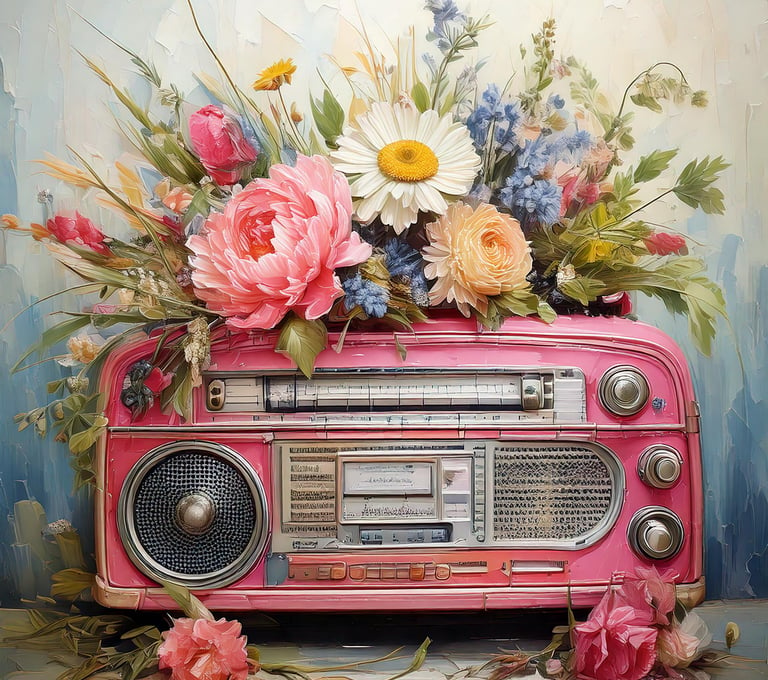afriads.io is live
Radio: Past, Present, and Future in Today’s Media Planning Landscape
Radio has long been a beacon of innovation and connection in the world of mass communication. From its humble beginnings as a means to transmit news and entertainment across airwaves to its current role as a dynamic, integrated medium in a digital ecosystem, radio continues to captivate audiences and influence media planning strategies. This article explores the evolution of radio, its current relevance in the media planning landscape, and the promising future that this time-tested technology holds.
mediatec.africa
2/18/20254 min read
A Historical Journey: The Golden Age of Radio
The Birth of an Era
Radio, as we know it today, began to take shape in the 1890s. While several inventors made significant contributions, Guglielmo Marconi is widely credited with its invention, notably after his breakthrough in 1895 when he successfully transmitted wireless signals over a distance. This milestone marked the birth of radio technology and paved the way for its evolution into today's dynamic medium.
It was not until the 1920s that radio began commercial use as Atwater Kent and RCA helped popularize consumer radio by mass-producing sets that could receive the first broadcast signals, marking the true beginning of radio as a household medium.
In the early 20th century, radio emerged as a revolutionary technology that bridged distances and brought communities together. Initially, radio was a novelty—a medium through which news, entertainment, and cultural programming reached homes worldwide. The era was defined by live broadcasts, serialized dramas, and a personal connection between the voice on the air and its listeners.
Cultural Impact and Storytelling
During its golden age, radio became a primary source of information and entertainment. Iconic programs, ranging from mystery dramas to variety shows, not only entertained but also influenced societal norms and perceptions. Radio played a critical role during times of national crisis and celebration, from the broadcast of wartime news to the joyous announcements of historic events.
Innovation in Advertising
The early days of radio also marked the birth of modern advertising. As brands began to see the value in reaching captive audiences, radio evolved into a powerful marketing platform. Creative jingles, live endorsements, and sponsorships became hallmarks of radio advertising, setting the stage for many strategies still in use today.
From Analog to Digital: Radio’s Evolution
Technological Advancements
The transition from analog to digital broadcasting in the late 20th and early 21st centuries transformed radio in profound ways. Digital radio offers clearer sound quality, a broader range of channels, and interactive features that traditional analog broadcasts could never achieve. This evolution has helped radio remain relevant by adapting to consumer preferences for higher-quality audio experiences.
The Rise of Podcasting and On-Demand Content
One of the most significant offshoots of traditional radio is podcasting. Offering on-demand, niche content, podcasts have reinvigorated the audio storytelling landscape. They allow creators to reach highly targeted audiences, providing media planners with a flexible platform to experiment with content formats and sponsorship models. The symbiotic relationship between traditional radio and podcasting underscores radio’s ability to innovate and adapt.
Integration with Digital Platforms
Today’s radio is not confined to car radios or home sets. It has seamlessly integrated into digital platforms—streaming services, mobile apps, and smart speakers are all part of the modern radio ecosystem. This digital transformation has not only broadened the listener base but also provided advertisers with rich, data-driven insights, enhancing targeting and measurement capabilities.
Radio in Today’s Media Planning Landscape
Widespread Reach and Engagement
Despite the proliferation of new media, radio continues to boast a vast and diverse audience. Its ability to reach listeners in various environments—while commuting, at work, or at home—makes it an indispensable tool in a multi-channel media strategy. For media planners, radio represents a channel that can deliver both broad reach and localized impact, making it ideal for campaigns that require geographic or demographic specificity.
Cost-Effectiveness and High ROI
In an era where digital advertising often comes with high price tags and complex bidding systems, radio remains a cost-effective alternative. Its relatively lower production costs and widespread penetration offer a high return on investment, especially for local businesses and regional campaigns.
Creative Synergy and Cross-Platform Campaigns
The adaptability of radio content fosters creative synergies across media channels. Integrated campaigns that combine radio with digital, social, and outdoor advertising can amplify messages and drive engagement. This multi-platform approach not only enhances brand recall but also leverages the unique strengths of each medium. Media planners are increasingly recognizing that radio’s storytelling power and emotional connection can serve as a cornerstone for cohesive marketing strategies.
Looking Ahead: The Future of Radio and Its Technology
Personalization Through Data Analytics
The future of radio is inextricably linked to advancements in data analytics and artificial intelligence. With sophisticated listener data and behavioral insights, radio programming and advertising can become even more personalized. Tailored content that meets the precise interests of individual listeners will not only improve engagement but also drive more effective, targeted advertising campaigns.
Voice-Activated Technologies and Smart Speakers
The growing prevalence of smart speakers and voice assistants is set to redefine the radio listening experience. As consumers increasingly turn to devices like Amazon Echo and Google Home for their audio content, radio broadcasters have the opportunity to integrate voice-activated features, creating interactive and immersive experiences. This trend also opens new avenues for advertisers to develop voice-optimized campaigns, blending traditional audio storytelling with cutting-edge technology.
Programmatic Radio and Real-Time Adjustments
Much like its digital counterparts, radio is moving towards programmatic advertising. This means that ad placements can be optimized in real time based on listener behavior and context. Programmatic radio promises more efficient buying processes and better alignment between ad content and audience demographics, making it an exciting frontier for media planners looking to harness the full power of data-driven marketing.
Sustainability and Community Engagement
As communities become more connected and socially conscious, local radio stations are likely to play a pivotal role in fostering community engagement. The authenticity and trust associated with local broadcasters make them ideal partners for campaigns centered on social responsibility and sustainability. Future radio strategies will likely emphasize community-centric content, enhancing both social impact and brand loyalty.
Conclusion
Radio remains a vibrant and influential medium, seamlessly bridging its storied past with a promising future. Its evolution—from the golden age of analog broadcasts to the digital, data-driven era—demonstrates its adaptability and enduring appeal. For media planners, radio offers unparalleled reach, cost-effectiveness, and creative potential, making it a critical component of integrated marketing strategies.
As we look ahead, the fusion of traditional radio with digital innovation—through personalization, voice technology, and programmatic advertising—will continue to redefine the landscape. Embracing these advancements will allow brands to craft compelling narratives that resonate deeply with audiences, ensuring that radio remains at the forefront of media planning for years to come.
By understanding radio’s rich history and anticipating its future trends, media planners can unlock new opportunities to connect with audiences in meaningful and impactful ways. Radio isn’t just a relic of the past—it’s a dynamic, evolving medium ready to meet the challenges and possibilities of tomorrow’s media landscape.


